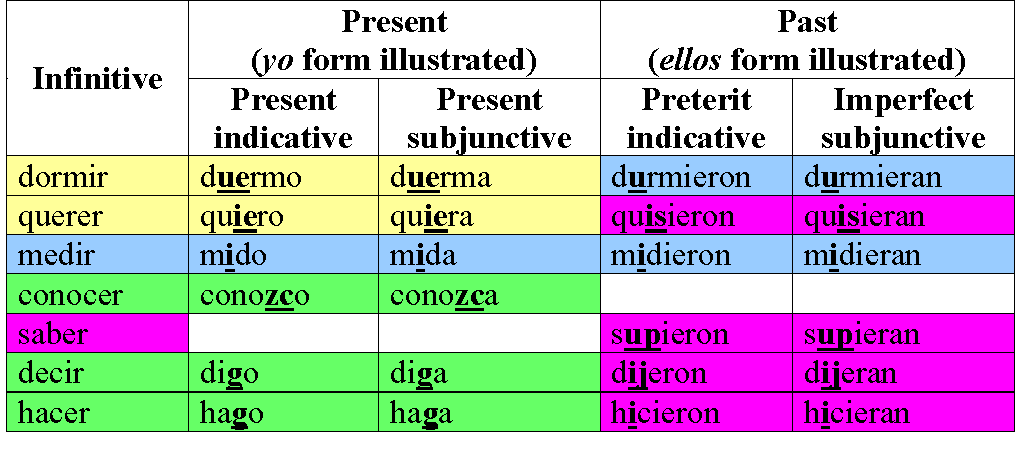

Think you’ve got it? Test yourself on the Spanish subjunctive with these fill-in-the-blanks exercises: Stem-changing -IR verbs are irregular and are thus explained on the irregular conjugations page.Spanish subjunctive conjugations are the same as imperative conjugations.In the subjunctive, the first and third person singular conjugations are identical.Stem-changing verbs: Stem-changing -AR and -ER verbs follow the above rules they use the same stem as in the present tense and thus maintain their stem changes in the subjunctive. If this seems too complicated, try this: take off the present tense ending and add the subjunctive ending. tú, él, and ellos forms – change E to A.IR verbs: The conjugation rules for -IR verbs are a bit more complicated. ER verbs: Take the present tense and change the E (or O) to A. It does not store any personal data.To conjugate regular -AR verbs in the subjunctive, take the present tense of the verb and change the A (or O, in yo form) at the beginning of the suffix to E. The cookie is set by the GDPR Cookie Consent plugin and is used to store whether or not user has consented to the use of cookies. The cookie is used to store the user consent for the cookies in the category "Performance". This cookie is set by GDPR Cookie Consent plugin. The cookies is used to store the user consent for the cookies in the category "Necessary". The cookie is used to store the user consent for the cookies in the category "Other. The cookie is set by GDPR cookie consent to record the user consent for the cookies in the category "Functional". The cookie is used to store the user consent for the cookies in the category "Analytics". These cookies ensure basic functionalities and security features of the website, anonymously. Necessary cookies are absolutely essential for the website to function properly. The players acted as if they had won the match.ĭaniel corría como si lo hubieran seguido.ĭaniel was running as if he had been followed.Ĭarmen caminó como si no me hubiera visto.Īlso see pluperfect / past perfect indicative in Spanish. Los jugadores actuaban como si hubieran ganado el partido. In Spanish, como si (as if) is used in hypothetical scenarios / expressions. If I talked to my boss, things would be better. Imperfect subjunctive: Si hablara con mi jefe, las cosas seran mejores. I don’t think I’ll talk to my boss today. Pluperfect Subjunctive Conjugation Verb ending in -er and -irįor past participle verbs ending in -er and -ir add the verb ending -ido.Ĭarlos esperaba que ellos hubiesen vendido ya el auto.Ĭarlos hoped they had already sold the car.Īmelia esperaba que Lucas le hubiera pedido ayuda.Īmelia hoped Lucas had asked her for help. Subjunctive mood : Spanish : English : Present Subjunctive: No creo que hoy hable con mi jefe. We would have bought the shoes before the discounts ended. Hubiéramos comprado los zapatos antes de que terminaran los descuentos. Pluperfect Subjunctive Conjugation Verb ending in -arįor past participle verbs ending in -ar add the verb ending -ado.ĭesearía que tú hubieses comprado los boletos. Imperfect subjunctive of the auxiliary verb haber + the past participle of the main verb Pluperfect Subjunctive Conjugation Table in Spanish Pronoun The Pluperfect Subjunctive is used to express doubt, wishes, uncertainty, possibility and hypothetical actions that took place before a specific past time or that would have taken place under different conditions. The Pluperfect Subjunctive in Spanish ( pluscuamperfecto subjunctive en español) is a compound tense in the past.
Subjunctive endings spanish pdf#
Past Perfect / Pluperfect Spanish Worksheet PDF Past Participle Spanish Exercise 1 / 2 / 3 / 4 Pluperfect Subjunctive Exercise 1 / 2 / 3 / 4

Past Perfect / Pluperfect Exercise 2 / 3 / 4 Past Perfect / Pluperfect Spanish Exercise 1


 0 kommentar(er)
0 kommentar(er)
